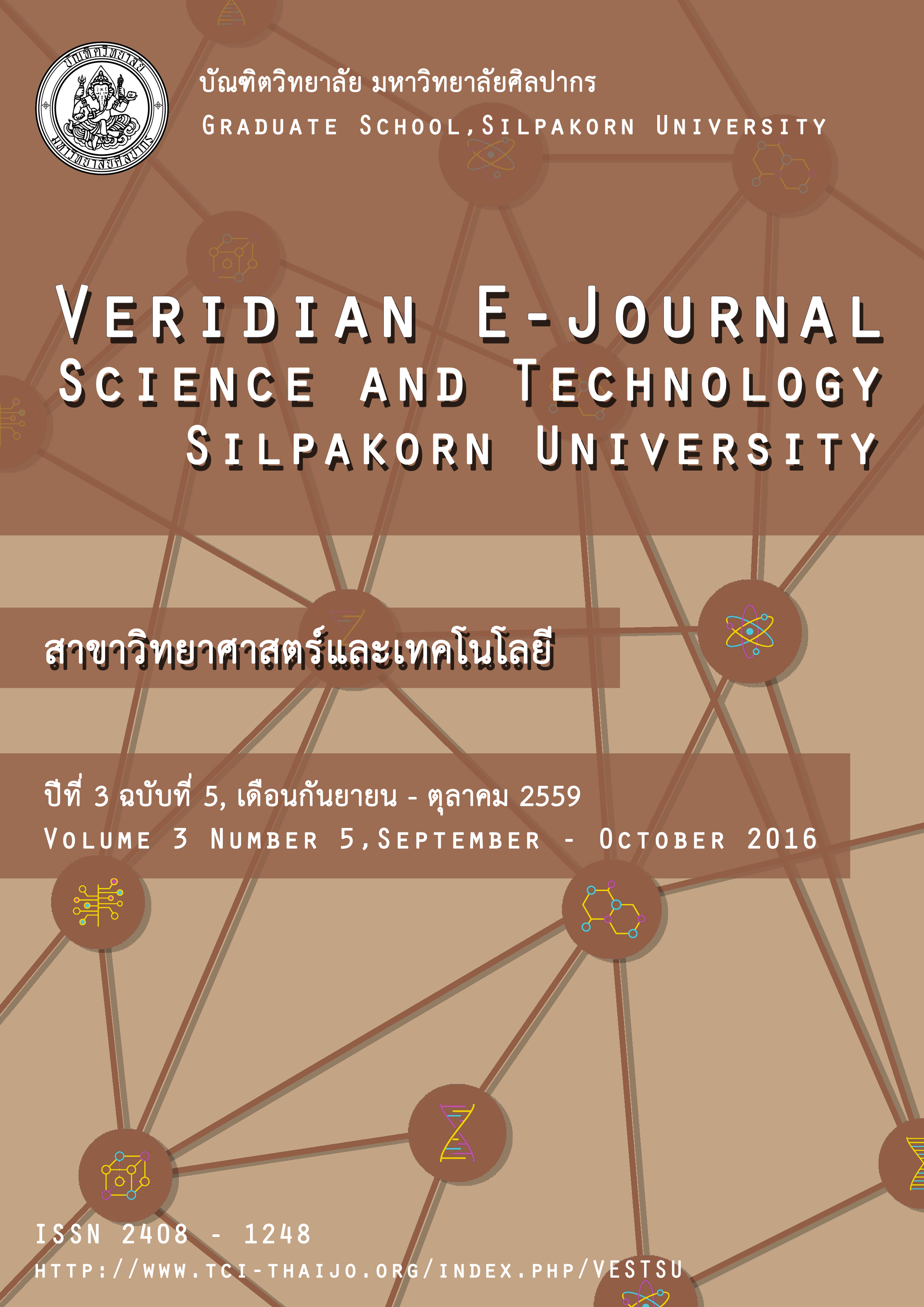ตัวคูณอัตราการระบายและอัตราการระบายฝุ่นขนาดเล็กกว่า 2.5 และ 10 ไมครอน* จากการปิ้งย่างอาหารด้วยเตาถ่าน
Main Article Content
Abstract
บทบาทของการปิ้งย่างอาหารที่มีต่อการระบายมลพิษออกสู่บรรยากาศนั้นสามารถบอกได้ด้วยค่าอัตราการระบายฝุ่น (Emission rate) การศึกษานี้ได้ตรวจวัดความเข้มข้นของฝุ่นขนาดเล็กกว่า 2.5 และ 10 ไมครอน (PM2.5 and PM10) จากการปิ้งย่างอาหาร 6 ชนิด ได้แก่ เนื้อหมู เนื้อไก่ เนื้อปลา เนื้อปลาหมึก มะเขือเทศ และสับปะรด ด้วยเตาถ่านในตู้ดูดควันที่ปิดสวิตช์ที่ทำหน้าที่เป็น Chamber ความเข้มข้นที่ได้นำไปหาค่าตัวคูณอัตราการระบายฝุ่น (Emission factor) ซึ่งต้องใช้ในการคำนวณหาอัตราการระบายฝุนต่อไป ความเข้มข้นของ PM2.5 และ PM10 ที่ได้ (มิลลิกรัมต่อลูกบาศก์เมตร) มีดังนี้ เนื้อหมู 0.77/0.80 เนื้อไก่ 1.13/1.19 เนื้อปลา 1.12/1.21 เนื้อปลาหมึก 1.29/1.31 มะเขือเทศ 1.43/1.52 สับปะรด 1.06/1.14 มิลลิกรัมต่อลูกบาศก์เมตร ซึ่งทุกค่าเกินค่ามาตรฐานคุณภาพอากาศภายในอาคาร เมื่อพิจารณารูปแบบการระบายมลพิษ (Emission pattern) จากสัดส่วน PM2.5 และ PM10 ซึ่งมีค่าอยู่ระหว่าง 0.92 – 0.98 พบว่า ฝุ่นส่วนใหญ่ที่เกิดขึ้นคือ PM2.5 ค่าตัวคูณอัตราการระบายฝุ่น (PM2.5/PM10) จากการปิ้งย่างเนื้อหมู เนื้อไก่ เนื้อปลา เนื้อปลาหมึก มะเขือเทศ และสับปะรด มีค่าเท่ากับ 0.34/0.36 0.34/0.36 0.20/0.22 0.23/0.24 0.17/0.18 และ 0.13/0.14 กรัมต่อกิโลกรัม ตามลำดับ ส่วนค่าอัตราการระบาย PM2.5 และ PM10 รวมจากการปิ้งย่างอาหารทั้ง 6 ชนิด ที่ มีค่าเท่ากับ 176.31 และ 184.59 ตันต่อปี ตามลำดับ ผลการศึกษาชี้ให้เห็นว่า ร้านขายอาหารปิ้งย่างควรมีการติดตั้งเครื่องบำบัดอากาศก่อนปล่อยออกสู่บรรยากาศ เพื่อสุขภาพของมนุษย์และสิ่งแวดล้อม
The role of charbroiling foods to air pollution emission can be described by emission rate. This study measured the concentration of particulate matter sizing smaller than 2.5 and 10 microns (PM2.5 and PM10) from charbroiling 6 kinds of food which are pork, chicken, fish, squid, tomatoes and pineapple. The food samples were grilled on charcoal stove in switched off fume hood that act as a closed chamber. The measured concentrations were used to identify emission factor which were later be used to calculate the emission rate. The concentrations of PM2.5 and PM10 in the unit of milligram per cubic meter are 0.77/0.80 pork; 1.13/1.19 chicken; 1.12/1.21 fish; 1.29/1.31 squid; 1.43/1.52 tomatoes; and 1.06/1.14 pineapple, where every value has exceeded the indoor air quality standard. Considering the emission pattern from PM2.5 and PM10 proportion that fall in the range of 0.92-0.98, it can be seen that the most particulate matter detected is PM2.5. The emission factors of PM fraction (PM2.5/PM10) from charbroiling pork, chicken, fish, squid, tomatoes and pineapple are equal to 0.34/0.36, 0.34/0.36, 0.20/0.22, 0.23/0.24, 0.17/0.18, and 0.13/0.14 gram per kilogram, respectively. The total emission rates of PM2.5 and PM10 from all activities are equal to 176.31 and 184.59 tons per year, respectively. The results of the study indicated that the air cleaner should be installed at the charbroiling shop/restaurant before release to the atmosphere for human health and environmental safety.
